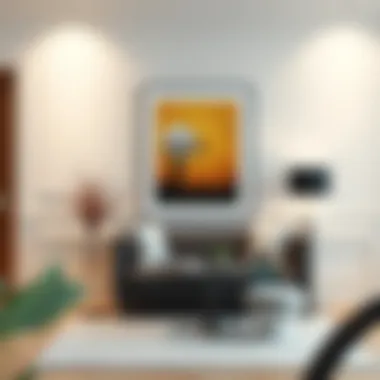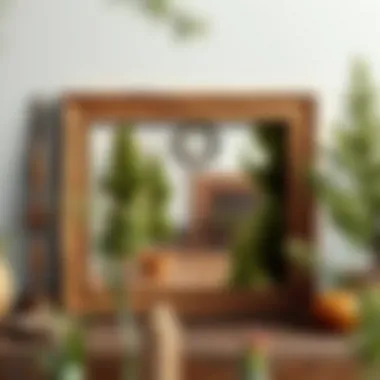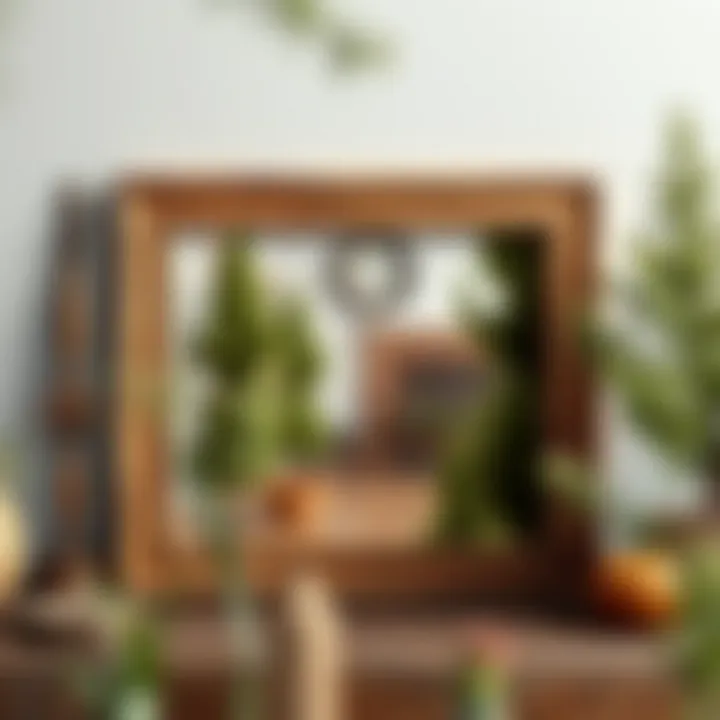The Complete Guide to Choosing Picture Frames


Intro
Picture frames are more than just glass and wood framing your cherished memories. They are an essential part of interior design, influencing the ambiance and character of a space. Whether you’re hanging family portraits, artwork, or even a simple postcard, the right frame can elevate the visual appeal significantly.
As one considers selecting a frame, numerous factors come into play. This article is your roadmap through the intricate maze of picture frames. We’ll cover everything from styles and materials to the latest trends. Additionally, we’ll touch upon techniques for effective display and methods to ensure your frames, and the treasures they hold, are well-preserved for years to come.
Navigating through this guide, you’ll gain insight that will help you make informed decisions tailored to your taste and the unique aesthetic of your space.
Furniture Trends
When it comes to picture frames, current design trends often mirror the broader shifts in interior decor. With the rise of minimalism, simpler frame styles have gained traction. But let's dive into the specifics.
Current Market Trends
In recent years, there has been a noticeable push towards eco-friendly materials. Many buyers are now seeking frames made from sustainable sources. Bamboo and reclaimed wood have become hot commodities. Additionally, mixed-media frames, which combine materials such as metal and glass, are increasingly popular, adding a modern flair.
Another trend is the rise of customized frames. Consumers are looking for unique pieces that reflect personal stories or styles. This shift toward personalization means more options for tailored shapes, colors, and finishes. Here’s what to keep an eye on:
- Eco-Friendly Options: Frames sourced from sustainable materials like bamboo or reclaimed wood.
- Mixed Media: Combining different materials for a contemporary look.
- Customization: Tailored features that reflect individual tastes and stories.
Popular Styles and Designs
Fashion changes swiftly, but some classic styles never fade. However, it's crucial to stay abreast of what styles resonate with today’s buyers.
Modern Minimalism: Clean lines and simple designs characterize this approach. Often finished in neutral colors, these frames tend to work well with various decor.
Vintage Touches: Retro frames often feature ornate designs and rich finishes. They can provide a striking contrast when placed against modern decor.
Gallery Walls: Arranging multiple frames of varying sizes and styles can create an eclectic but coordinated gallery wall. This trend encourages creativity and personalized storytelling through art.
In summary, understanding current market trends and styles can help inform your choices, ensuring the frames you purchase not only serve their purpose but also enhance the overall aesthetic of your space.
"Frames are a window to the past, holding our memories and art in a way that both protects and showcases them."
As we move forward, we will explore DIY projects that can save you some bucks while adding a personal touch to your decor.
Understanding Picture Frames
Understanding picture frames revolves around grasping their role beyond mere protective barriers for artwork. They serve as a crucial element in home decor that can elevate the aesthetics of any space. People often overlook just how much a well-chosen frame can contribute to the atmosphere of a room. It's not just about displaying a picture; it's about complementing it, enhancing its visual story, and tying in with the overall decor theme.
Picture frames are not merely functional items; they act as the bridge connecting the artwork to the viewer. A great frame highlights the colors, captures the eye, and can even evoke emotions before any art is viewed. Opting for the right frame is much like picking an outfit for a special occasion; the right choice can enhance the overall impression significantly.
The Role of Picture Frames in Decorating
When it comes to decorating, picture frames play a fundamental role. They can transform empty walls into storytelling canvases. Whether you’re sporting a gallery wall with a mix of family portraits and art prints or simply showcasing a landscape painting above the sofa, the frame has the power to unify or diversify a collection.
Choosing the right frame style, color, and material becomes a matter of aligning with your personal style. For instance, a sleek, modern frame can create a more contemporary ambiance, whereas a vintage wooden frame can exude warmth and coziness. Here are some ways frames contribute to decor:
- Color Harmony: Frames can help in coordinating colors within a room, acting almost as secondary art.
- Style Alignment: They can complement or contrast with existing decor styles, drawing attention or blending seamlessly.
- Visual Heightening: A well-framed piece can draw the eye upward in a room, making ceilings feel taller.
Cultural Significance of Picture Framing
Picture framing carries cultural weight, reflecting societal values and artistic trends through time. In many cultures, the act of framing artwork is deeply embedded in traditions. For example, in some Asian cultures, intricate gold frames envelop portraits of ancestors, signifying respect and memory. In this way, picture frames serve as cultural artifacts themselves, representing status and an appreciation for art.
Frames can also offer insights into a culture's artistic past. Historically, ornate frames were symbols of wealth and status, while simple designs have become synonymous with modern minimalism. The choice of material and craftsmanship can signal everything from local artisan techniques to global trends.
Furthermore, the act of framing images—whether it's at an art exhibit or in a personal space—highlights the connections between individuals and their environments, showcasing what is valued or esteemed aesthetically.
In short, the significance of frames goes beyond the walls they adorn. They encapsulate personal stories, cultural heritage, and the evolving narrative of art and decoration itself. By understanding the complexities behind picture frames, one can make informed choices that honor both the artistry contained within and the space it occupies.
Types of Picture Frames
When it comes to purchasing picture frames, understanding the different types available is crucial. The type of frame you select can significantly influence the visual appeal of your artwork and how it harmonizes with your overall decor. Types of picture frames range from classic designs to modern styles, each carrying its unique character and charm. This section explores the various categories of frames available, ensuring you have a firm grasp of what each type offers and how they might serve your specific needs.
Traditional Frames
Traditional frames evoke a sense of nostalgia and timeless elegance. These frames often feature rich woods and intricate moldings, crafted to complement vintage photographs or classic artworks. Imagine a beautifully carved wooden frame surrounding a family portrait or a still life painting; it not only enhances the piece but also tells a story of grace and history.
Typically, traditional frames are made from materials such as oak, cherry, or mahogany. They benefit from being sturdy and provide quality that may outlast more modern options. Keep in mind that the weight of these frames can vary, which may impact hanging techniques and wall choices. When selecting a traditional frame, consider how it mirrors your personal taste and the style of the room, creating a space that feels cohesive and thoughtful.
Modern and Contemporary Frames
Modern and contemporary frames break the mold of tradition. They tend to favor simplicity in design, utilizing materials like metal and acrylic, characterized by clean lines and minimalism. These frames suit a variety of contemporary art styles, from abstract prints to photography, and they often serve as a statement piece themselves.
One of the advantages of modern frames is their versatility; they can appear sleek in a gallery wall or serve as a focal point on a shelf. They pull your eye in and let your artwork shine without distraction. It's essential to select a frame that matches not just the artwork but also its environment since a modern frame in an overly ornate setting could clash.
Custom Frames
Sometimes, mass-produced frames simply won’t do. This is where custom frames come into play, allowing for a tailored approach that considers the specifics of your artwork. Custom framing can accommodate unusual sizes, unique artworks, or specific design preferences. Imagine longing for the perfect finish that brings out the vibrancy of your art; custom framing can often fulfill that desire.


The process may involve working with a professional framer who can guide you through options for design, materials, and glass choices. While it may be a more expensive route compared to off-the-shelf frames, the result is often worth every penny. A custom frame not only enhances the work but secures it properly, ensuring its longevity. It’s the perfect solution for pieces that carry personal significance and require that extra level of care.
"Choosing the right frame is as significant as the artwork it holds."
In summary, understanding the types of picture frames—traditional, modern, and custom—offers essential insights that help any homeowner or designer make informed decisions. Depending on the artwork, each type has its unique advantages, contributing to the overall aesthetic and preservation of your cherished pieces.
Materials Used in Picture Frames
When selecting picture frames, the materials used play a vital role not just in aesthetics but also in durability and functionality. Each type of frame material comes with its own set of characteristics that can affect the overall look and feel of your artwork, as well as its longevity. Understanding the materials available helps one make informed choices. It can be the difference between a cherished item lasting for years or succumbing to wear and tear within a short time.
Wooden Frames
Wooden frames are often favored for their warm and classic appeal. They come in a variety of finishes, making it easy to find one that matches the decor of any space.
- Benefits of Wooden Frames:
- Versatility: They can be stained, painted, or left natural, offering a range of looks from rustic to modern.
- Durability: A well-crafted wooden frame can withstand the test of time, provided it is cared for properly.
- Insulation: Wood naturally helps in maintaining temperature stability, which can benefit the artwork inside.
However, buyers should also consider the maintenance aspect. Wooden frames may need periodic attention to prevent warping or cracking, especially in environments with fluctuating humidity. If one prefers an earthy feel to their decor, wood frames can truly enhance the ambiance.
Metal Frames
Metal frames have increasingly gained popularity due to their sleek and contemporary look. Often made from aluminum or steel, they provide a modern contrast to artworks.
- Advantages of Metal Frames:
- Strength: Their sturdy construction offers protection, particularly for larger pieces.
- Low Maintenance: Metal frames are generally easier to clean and do not have the natural wear issues that wooden frames might face.
- Customization: Many metal frames are available in various finishes and colors, including matte and glossy, allowing for endless design possibilities.
On the flip side, metal frames can lack the warmth found in wooden frames, potentially giving a cold or clinical feeling. They are ideal for showcasing modern art or black and white photographs, where minimalism can enhance the visual impact.
Plastic Frames
Plastic frames, often the most budget-friendly option, offer a myriad of vibrant colors and shapes. They can serve as excellent choices for children’s artwork or casual settings.
- Perks of Plastic Frames:
- Affordability: They are generally much cheaper than wood or metal, making them perfect for those who might prefer frequent changes in decor.
- Lightweight: Easy to hang or move without much hassle, even in larger pieces.
- Variety: Available in almost every color possible, allowing for fun and creative displays.
Nevertheless, it's crucial to understand that quality can vary significantly in plastic frames. Cheaper options might fade in sunlight or become brittle over time. They might not provide the same level of sturdiness or sophistication as wooden or metal frames, but they have their niche.
"Choosing the right material for your picture frame is not just about style; it's also about how you want your artwork to be preserved and displayed."
In summary, the choice of frame material should align with both the artwork's character and the environment it will inhabit. While the classic elegance of wooden frames, the modern finesse of metal frames, and the playful nature of plastic frames all offer unique advantages, the artist’s and viewer's preferences must ultimately guide the selection process.
Selecting the Right Frame
Selecting the right frame might seem like a simple task, but it carries a weight that can truly transform the look and feel of your artwork. The notion is akin to choosing the perfect outfit for a special occasion; you wouldn't simply settle for just any attire. Frames serve not only to protect your artwork but also to elevate it – enhancing its impact in your space. When done right, the selected frame can harmonize with your decor and set off the colors and details of the artwork within.
Considerations for Artwork Type
When it comes to selecting an appropriate frame, the type of artwork you possess plays a crucial role. Different styles and mediums demand different approaches. For instance, the thick, textured layers of an oil painting may benefit from a more substantial, traditional frame that can complement its depth. In contrast, a delicate watercolor or a print might shine best in a sleeker, contemporary frame that does not overwhelm its subtle hues.
- Size Matters: The dimensions of the artwork should dictate the frame size. A frame that’s too small will stifle the piece, while an oversized frame can detract from its essence.
- Medium Considerations: Reflect on the medium. A simple pencil sketch deserves more than just a glass overlay; consider a frame that adds a touch of elegance without drawing too much attention from the art itself.
- Artwork Style: Abstract works can be paired with minimalist frames to keep focus on the art. Meanwhile, a classic portrait may benefit from intricate framing that speaks to its historical context.
Matching Frame Style to Decor
Picking out a frame that complements your existing decor is like connecting the dots in a larger picture. Your space has a personality, and the frame should echo that vibe. Imagine a rustic wooden frame in a modern loft; while it might stand out, it would not quite fit into that stylish narrative.
- Modern Spaces: In a room that leans towards sleek lines and minimalism, consider metal frames with clean edges. This choice protrudes the idea that less is indeed more.
- Traditional Interiors: If your home flaunts an elegant, classic style, opt for ornate frames embellished with gold or dark wood finishes. This adds a richer story to your artwork.
- Eclectic Mix: For those who love a jumble of styles, going with different frame designs intentionally becomes a form of art itself. Just ensure there's some governing factor—like color scheme—to tie it all together, allowing the frames to create a cohesive visual narrative.
Color Coordination and Aesthetics
This is where the rubber meets the road; color choices in framing can lead to spectacular outcomes or complete fizzles. It’s about creating a pleasant harmony between the art, frame, and surrounding decor.
- Matching Colors: Try to pick colors that either match or contrast effectively. For instance, if the artwork is predominantly blue, a frame that includes hints of blue can lift it and create a melodious connection.
- Matte vs. Glossy: Don’t overlook finishes. A matte frame can instill a sense of calm and sophistication, while a glossy finish reflects light, drawing in the eye. Choose according to the atmosphere you want to create.
- Consult the Color Wheel: For those not well-versed in color theory, the trusty color wheel can be a lifesaver. Opposing colors evoke excitement, whereas analogous shades provide a serene feel. Making use of this tool can ease decisions and lead to vibrant results.
In sum, the right frame can significantly transform your artwork, bringing out the best in colors, styles, and decor. Keep in mind the artwork type, the surrounding elements, and the emotional tone you wish to evoke when making your choice. Remember, it’s not just about enclosing art; it’s about presenting it in a way that enhances its narrative in your space.
Frame Sizes and Dimensions
When it comes to selecting a picture frame, understanding sizes and dimensions is crucial. After all, a frame not only serves the purpose of displaying artwork but also complements the piece and the surrounding environment. Getting the right dimensions affects the overall aesthetic of a space, balances proportions, and can even dictate the viewer's experience with the artwork itself.
Many homeowners, designers, and DIY enthusiasts find themselves at a crossroads when it comes to matching the size of the frame with their artwork. Choosing the wrong size can lead to disproportionate displays that make the art feel cramped or oversize. Opting for standard sizes can simplify the decision-making process for many, while custom dimensions may be necessary for unique artworks.
Standard Frame Sizes
Standard frame sizes are like the bread and butter of picture framing. They often come in commonly found sizes, such as:
- 4 x 6 inches
- 5 x 7 inches
- 8 x 10 inches
- 11 x 14 inches
- 16 x 20 inches
- 24 x 36 inches
These sizes are widely available in craft stores and online retailers. Utilizing standard sizes can save both time and money, as these frames are generally less expensive than their custom counterparts. Moreover, they offer a range of styles and materials, making it easier to find something that fits your design sensibility.


However, it is essential to note that while standard sizes cater to popular art dimensions, they may not work for every piece. Before purchasing, consider not only the piece's dimensions but also whether matting will be used, as this can add additional size requirements.
Working with Custom Dimensions
On the flip side, custom frames provide a tailored solution for those unique pieces that don't fit standard sizes. Whether it's a family heirloom, a large canvas, or a striking piece purchased at a gallery, sometimes a custom dimension is the only way to go.
When you decide to go custom, several factors come into play:
- Precision Measurements: Measure your artwork carefully. The height and width are critical, but also consider the thickness if you’re framing a three-dimensional piece.
- Matting Options: Adding matting can enhance the artwork but also increases the dimensions. Custom framers can help you choose the right mat width to complement the piece without overwhelming it.
- Choosing Frame Profiles: Custom framing allows you to select the profile that best fits the artwork—be it ornate, simple, or something in between. The right profile can make the artwork pop or blend seamlessly into the background.
Working within these custom parameters might be a bit pricier, it’s worth noting that custom framing elevates the overall presentation of art. Not only does it ensure a perfect fit, but it also enhances the longevity of the artwork by providing adequate protection based on the material used for the frame and glass.
"When it comes to picture frames, it’s not just about enclosing art, but ensuring it looks its very best while also protecting it from dust, light, and other environmental factors."
Choosing the right frame size, whether standard or custom, is a pivotal moment in the framing process. The right dimensions provide a supportive structure for your artwork, ensuring that it can be appreciated for years to come in its best light.
Display Techniques for Picture Frames
When it comes to showcasing your artwork, the way you display your picture frames plays a pivotal role in setting the mood and emphasizing the piece itself. Display techniques can transform an ordinary object into a striking focal point within any room. Understanding these methods will help homeowners, renters, designers, and DIY enthusiasts make thoughtful decisions about how to present their framed artworks, leading to not just aesthetic joy, but also to a nuanced understanding of spatial dynamics and atmosphere.
Wall-Mounted Displays
Wall-mounted displays are perhaps the most traditional and popular method of showing off framed pictures. Often seen in living rooms, hallways, and even kitchens, wall-mounted displays not only utilize vertical space effectively but also create a sense of connection between the artwork and the environment.
- Considerations for Height and Positioning: When hanging frames, one must consider the height at which they are placed. Art should generally be hung at eye level, which is typically around 57-60 inches from the ground. This makes it comfortable for most viewers to appreciate the details.
- Artistic Layout: The arrangement of multiple frames can convey a story or theme. A grid layout appeals to those who prefer a structured look, while an asymmetrical layout can create a dynamic feel. Experimenting with positioning can lead to surprising, yet harmonious results.
"A well-placed frame can act much like a window to another world, pulling viewers in and inviting them to linger longer."
- Use of Lighting: Proper lighting can highlight the artwork and enhance the overall atmosphere. Wall sconces or specially directed spotlights can create an engaging interplay of light and shadow, accentuating the colors and textures in the framed pieces.
Tabletop and Shelf Displays
Tabletop and shelf displays offer versatility and accessibility for showcasing picture frames. They allow for easy rotation of artwork and can accommodate various frame sizes without permanent commitment.
- Focal Points: Using a cluster of frames can serve as a striking focal point on a mantel or a shelf. Mixing different sizes and styles can create visual interest, but it’s best to maintain some cohesive elements, such as color schemes or materials.
- Interspersing with Decorative Items: Combining framed pictures with other decorative items—vases, books, or plants—can create an inviting and curated look. It reflects a person’s style while adding depth to the display.
- Dynamic Displays: One of the biggest advantages of tabletop displays is that they can be easily rearranged. Changing a few frames every season or to reflect a recent trip can keep the setup fresh and enjoyable.
Gallery Walls and Arrangements
Creating a gallery wall can turn a blank space into a personal exhibition. This technique has gained popularity for its ability to showcase not just art but memories and reflections of one’s personality.
- Selecting a Unified Theme: Whether it’s a color palette, subject matter, or framing style, having a cohesive theme can enhance the overall aesthetic. It prevents any one piece from feeling out of place.
- Layering and Depth: To achieve depth, consider varying the spacing between frames. Closer spacing draws focus to certain areas, while wider gaps can create breathing room and emphasis on each artwork.
- Experiment with Sizes: Don't shy away from mixing large pieces with smaller ones, as it can add visual intrigue. Just remember to avoid clutter; each piece should have its moment to shine without competing.
While the techniques of displaying picture frames may seem straightforward, the right approach can elevate your decor significantly. Whether you choose to adorn your walls or create an artistic tableau on a table, remember that each piece tells a story. The way you choose to showcase it can enhance its narrative and make a powerful statement in your living space.
Maintaining and Preserving Picture Frames
Picture frames, while often overlooked, play a critical role in not only showcasing artwork but also in preserving the integrity of the pieces they encase. Just like a good pair of shoes, which can wear down without proper care, picture frames require regular maintenance to keep them looking their best and functioning as intended. Understanding how to maintain and preserve your frames can ensure they continue to enhance your decor for years to come.
Cleaning Techniques
Cleaning picture frames is much like cleaning any other decorative item in your home; it requires a gentle touch and the right tools. Dust and grime can accumulate over time, detracting from the beauty of both the frame and the artwork it protects. Here are some effective techniques to keep in mind:
- Dust Regularly: A soft, dry microfiber cloth is your best friend here. Gently wipe the frame surfaces to remove surface dust.
- Avoid Moisture: Use a slightly damp cloth only if necessary, but be cautious. Too much moisture can warp the frame or seep into the artwork.
- Choose Appropriate Cleaners: For wooden frames, a light wood polish can help, while metal frames might benefit from a specialized metal cleaner. Avoid harsh chemicals; they can do more harm than good.
- Use Cotton Swabs for Intricate Areas: When tackling ornate or detailed frames, cotton swabs can help reach tight spots without damaging the frame.
Cleaning your frames should become a part of your routine. A well-maintained frame not only stands up to the test of time but also keeps the artwork it contains in the best possible condition.
Long-Term Preservation Tips
Preserving picture frames isn't just about cleaning; it's about ensuring they last through the ages. A few thoughtful strategies can prolong their life significantly:
- Store Properly: If you need to store frames, wrap them in acid-free tissue paper and place them in a climate-controlled environment. Avoid overly humid or dry spaces to prevent damage.
- Mount it Right: Ensure that frames are hung or displayed in areas away from direct sunlight and heat sources. UV rays can fade artwork and materials over time.
- Use Glazing Wisely: Consider using UV-filtering glass or Plexiglas, as these materials can block harmful light rays while protecting the artwork.
- Evaluate Regularly: Every few months, take time to inspect your frames for any signs of wear or damage. Catching issues early can save you from costly repairs later.
By incorporating these tips into your picture frame care routine, you’ll not only maintain their aesthetics but also protect the valuable memories and art they hold.
Keeping picture frames in good condition protects your art and enhances your space. A little love goes a long way in preservation.
To learn more about the importance of frame preservation and the materials that can aid in this process, explore resources such as Wikipedia or Britannica. The effort you invest in maintaining your picture frames will be reflected in their continued beauty and functionality.
Market Trends in Picture Frames
The realm of picture frames is not just about functionality; it's a dynamic sector that reflects the shifting tides of design and consumer preferences. Understanding market trends in picture frames can provide critical insights for homeowners, designers, and retailers alike. As we navigate through various styles, materials, and sustainable practices, staying informed about the latest trends equips buyers to make choices that enhance their visual narrative.
Not only do these trends influence aesthetic appeal, but they also impact value. A keen awareness of current design concepts can save buyers from making missteps that lead to buyer’s remorse.
Current Design Trends
In today’s market, home decor is leaning heavily into personalization. People want frames that speak to their individual style and experiences. Here are some notable trends:
- Minimalist Aesthetics: Simple, clean lines are taking center stage. Frames with minimal ornamentation in neutral colors tend to highlight the artwork and can fit into any decor style.
- Mixed Materials: There is a noticeable rise in frames that combine wood with metal accents. This fusion creates a modern twist while ensuring durability.
- Bold Colors and Patterns: While some opt for subtlety, others are going all out with vibrant colors or unique patterns. A colorful frame can serve as the focal point in a neutral room, breaking monotony.


These playful yet thoughtful design choices resonate with those looking to make a statement while harmonizing with their surroundings.
Sustainability in Frame Production
Sustainability is not merely a buzzword; it's becoming a standard expectation among conscious consumers. The picture frame industry is witnessing an increased demand for eco-friendly practices that minimize harm to the environment. Here are some facets worth noting:
- Recycled Materials: Frames manufactured from recycled plastics or reclaimed wood are gaining traction. Not only do they reduce waste, but they also offer consumers a unique story about the materials’ previous life.
- Local Production: Supporting local artisans and businesses helps reduce carbon footprints tied to transportation. Many consumers are keen on purchasing frames that are made locally, contributing to local economies.
- Non-toxic Finishes: The move towards using non-toxic paints and finishes is essential for those mindful of air quality and chemical exposure, especially in homes with small children or pets.
"Sustainable practices in picture framing not only benefit the environment but also enhance the narrative of the artwork displayed."
The commitment towards sustainability not only reflects a responsible choice but signals a shift in consumer values, emphasizing care for our planet. As techniques and materials evolve, buyers are encouraged to consider how their purchases align with their ethical standards.
In summary, staying abreast of market trends in picture frames is crucial. Whether you’re a retailer selecting inventory, a designer curating a collection, or a homeowner choosing the perfect frame, understanding these trends enables you to make informed decisions. The world of picture framing is far more than about hanging pictures; it’s about defining spaces and telling stories.
Where to Buy Picture Frames
When it comes to selecting the perfect picture frame, knowing where to buy them can be just as essential as understanding styles or materials. The right point of purchase can influence not only the quality of the frame but also the overall shopping experience. Whether you’re a designer seeking unique pieces or a DIY enthusiast looking for budget-friendly options, the location of your purchase can greatly affect your choices.
Buying a picture frame is more than just a transaction; it’s about finding a piece that resonates with your aesthetic and enhances the artwork it holds. Plus, having options available nearby or online can be a lifesaver, especially when you’re in a hurry to finish a decorating project. Let’s break down the different avenues available for sourcing picture frames.
Online Retailers
In today’s fast-paced digital world, online retailers have become a go-to for many buyers. Websites such as Amazon, Etsy, and Wayfair offer a plethora of choices ranging from simplistic designs to extravagant frames. The vast selection allows you to compare prices and styles without leaving the comfort of your home.
One significant advantage of shopping online is the access to customer reviews. You can get a sense of how a frame looks in real life rather than relying solely on a product image. Additionally, many online platforms provide detailed specifications, including dimensions, material types, and color options, ensuring you know exactly what you’re getting.
However, it's vital to consider shipping costs and delivery times, as these can add unexpected expenses or delays to your project. Be sure to check for return policies, just in case the frame doesn’t meet your expectations upon arrival.
Local Art Supply Stores
Stepping into a local art supply store can feel like walking into a treasure trove, especially for those who value personal interactions. Stores such as Michaels or Hobby Lobby often carry a variety of frames that cater to specific needs, such as custom sizes or unique styles. Shopping locally can provide a tactile experience; you can see and feel the frame before deciding.
Moreover, local stores frequently have knowledgeable staff who can provide tailored recommendations and advice. If you have a particular piece of art in mind, they can assist you in choosing a frame that matches or complements it perfectly. Plus, many local art supply stores offer workshops or seminars on framing techniques, giving you a chance to learn directly from the experts.
Specialty Frame Shops
For those who prioritize craftsmanship or are on the lookout for one-of-a-kind frames, specialty frame shops are the way to go. These shops, such as Framebridge or local bespoke frame creators, focus solely on framing and often provide a level of customization that larger retailers cannot match. Here, you can select every aspect of the frame, from the color and material to the finish and matting.
Choosing a specialty frame shop allows for tailored service. The experts can walk you through the selection process, considering factors like the artwork’s style and the intended display location. Additionally, specialty shops may offer preservation framing, protecting your artwork from damage caused by light or moisture, which is vital for valuable pieces.
"A picture frame is more than just a border — it's the finishing touch that elevates your art to new heights."
In sum, the right place to buy picture frames ultimately depends on your individual needs and preferences. With options ranging from online retailers that offer convenience and variety, local art supply stores providing hands-on experiences, to specialty frame shops boasting unmatched expertise, there is a frame out there just waiting to complement your cherished artwork.
Budget Considerations for Picture Framing
When it comes to picture framing, budgeting plays an essential role in the decision-making process. It's not simply about allocating a certain sum of money to frame something; it involves a nuanced understanding of how much you are willing to spend versus the value you expect to gain. Whether you're a homeowner looking to spruce up your living room or a designer seeking to showcase artwork, keeping a budget in mind will save you from unnecessary stress and help make robust choices.
Let's face it: the framing industry offers a cornucopia of options, ranging from economical to extravagant. It’s easy to get swept up in the whirlpool of beautiful frames only to realize that your wallet is feeling a bit lighter than you intended. Thus, understanding the importance of budget in this context cannot be understated.
Setting a Frame Budget
So how do you go about setting a budget for your framing needs? First things first, assess your overall financial situation. Determine how much you can realistically spend without putting a strain on your finances. Here are some practical steps to help you set a frame budget that aligns with your objectives:
- List Your Artwork: Make an inventory of the pieces you plan on framing. Note their dimensions and styles since some may demand specific types of frames or materials.
- Research Costs: Look into the average prices for the types of frames that would complement your artwork. Different materials and styles carry varying price tags—while wooden frames tend to be classic and sturdy, they may also cost more than plastic counterparts.
- Consider Additional Costs: Don’t forget about other expenses, such as glass or matting. Depending on your choice, these can add up quickly and should be factored into your budget.
By keeping these items in mind, you can draw up a budget that is both realistic and adequate for your needs.
Value vs. Cost of Frames
Once you’ve established a budget, a common question emerges: should you prioritize value or cost? It’s an age-old dilemma, and the decision often hinges on your personal preferences and the significance of the artwork in question.
When discussing value versus cost, it’s important to consider the longevity and quality you expect from a frame. Here are some points to reflect on:
- Quality Over Price: Investing a little more in a well-crafted frame can provide added durability and aesthetic appeal. A cheaply made frame can detract from the artwork and, in some cases, even damage it over time.
- Emotional Connection: If the piece holds sentimental value, you may find it worthwhile to spend more to ensure it’s showcased properly. Think about that family portrait or artwork from your kids—framing it cheaply might not do justice to its significance.
- Resale Potential: For collectors or those considering resale in the future, a high-quality frame can elevate the perceived value of the artwork. While a cheap frame may save you money up front, it could result in losses down the line if you aim to sell.
Epilogue
In the realm of decorating, picture frames often serve as the silent yet pivotal characters, adding dimension, warmth, and personal touch to spaces. It’s vital for homeowners, renters, designers, or anyone eyeing to jazz up their decor to recognize the power these unassuming items hold. In this guide, we’ve traversed a myriad of factors associated with picture frames, emphasizing their role far beyond mere holders of art.
Recap of Key Points
As we've discussed, here are the essential takeaways from our exploration of picture frames:
- Importance in Design: Picture frames are not just functional. They enhance the aesthetic appeal of photographs or artwork, making the surroundings feel more cohesive.
- Variety of Types and Materials: There exists an extensive range of frame types—from traditional to contemporary—crafted from diverse materials including wood, metal, and plastic, thus catering to various tastes and styles.
- Selecting the Right Frame: Understanding factors like the type of artwork, style of decor, and color scheme can significantly influence the choice of frame, enhancing the visual experience.
- Display Techniques: There's a wealth of display options, such as gallery walls or tabletop arrangements, that bring a personal note to the decor.
- Maintenance and Preservation: We touched on cleaning techniques and long-term preservation tips to ensure the longevity of frames, highlighting their enduring value.
- Market Trends: Keeping an eye on trends ensures that your choices remain fresh and in line with contemporary aesthetics.
- Budget Considerations: Setting a sensible budget is crucial, allowing for both value and affordability in your frame selection.
Final Thoughts on Picture Frame Selection
While picture frames may feel like a trivial consideration in design, their selection holds greater weight. A well-chosen frame can elevate an entire space, serve as a conversation starter, and reflect the personality of its inhabitant. When selecting, consider all aspects, from the artwork itself to how it meshes with your decor style. Stay aware of market shifts, which can impact availability and trends in frames. Don't merely settle for what's on the shelf—think about what complements and enhances your home. The right frame doesn't just hold your memories; it amplifies their beauty!
"A picture frame is a doorway to memories, encapsulating not just the image, but the emotion it carries. Choose wisely, and let your frames speak your story."
With these insights, you're now equipped to approach the world of picture frames with confidence and clarity, making choices that reflect your unique style while addressing practical needs.
For additional information, you may find resources on picture frame selection at Wikipedia and Britannica.
Embrace the diverse options available and enjoy the art of framing!















